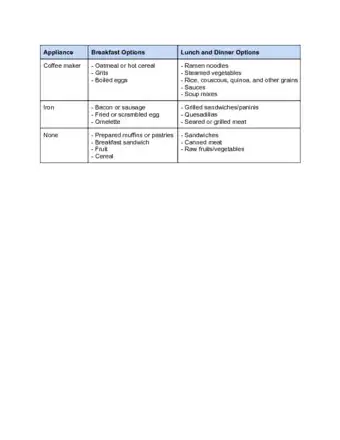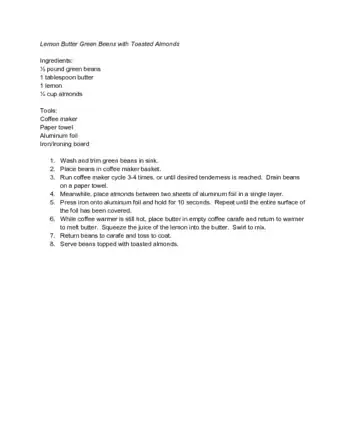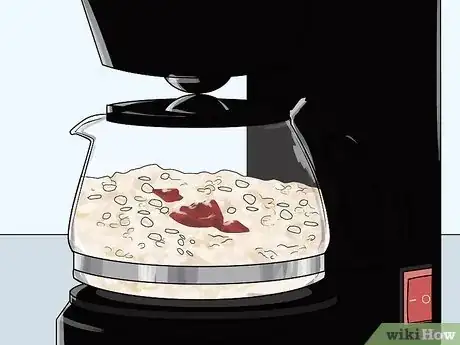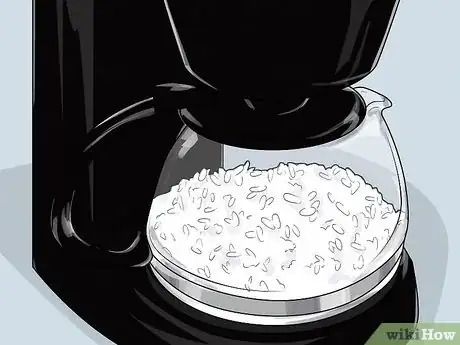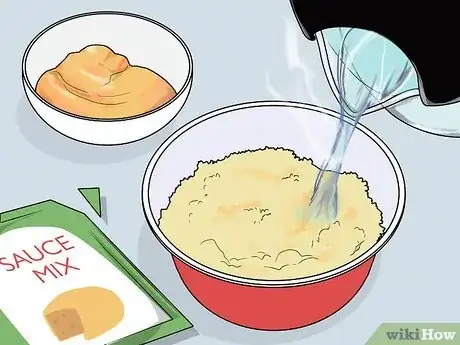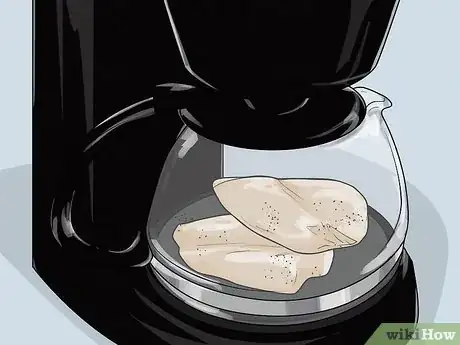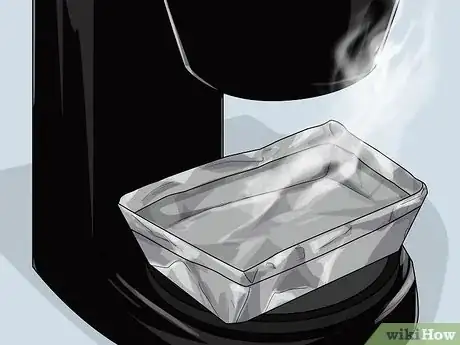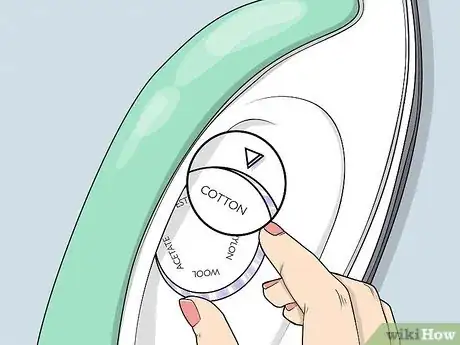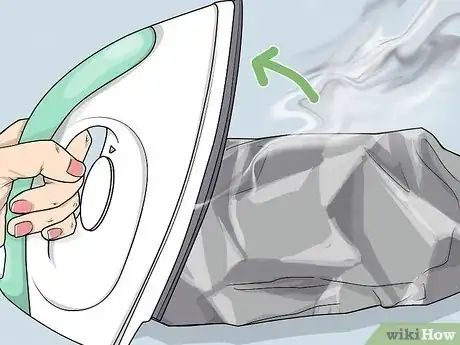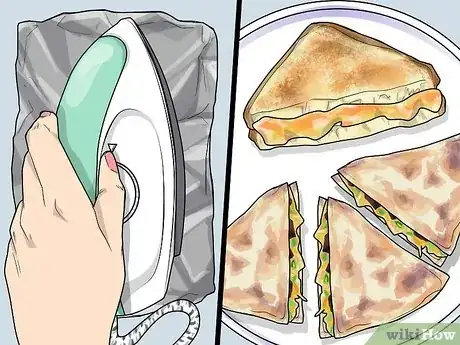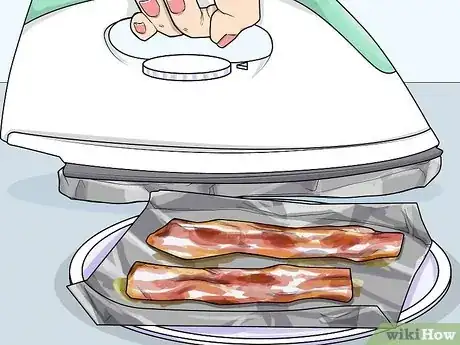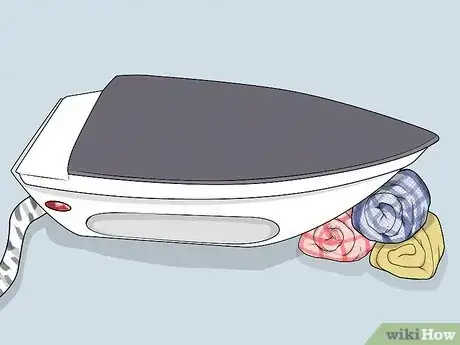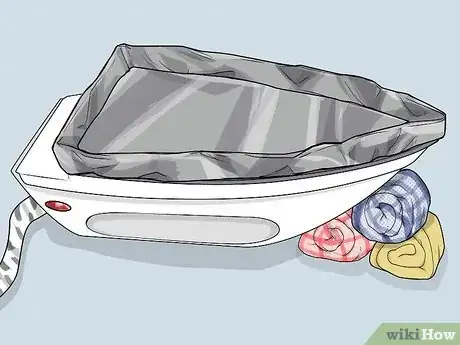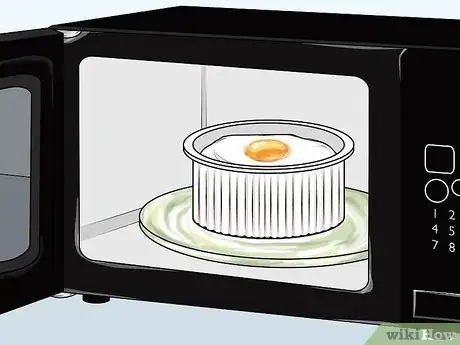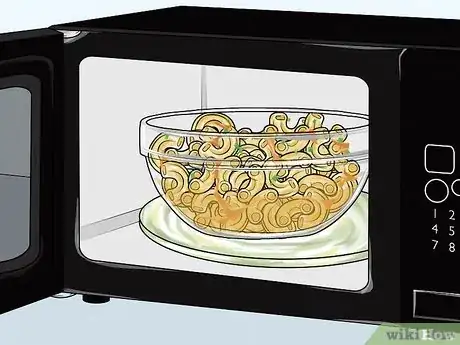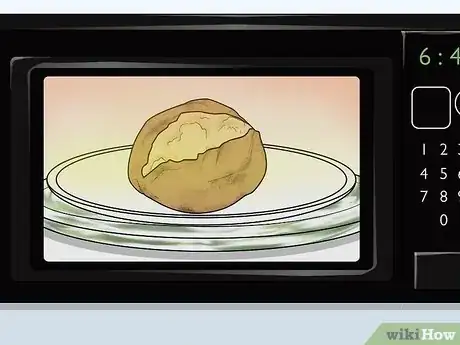wikiHow is a “wiki,” similar to Wikipedia, which means that many of our articles are co-written by multiple authors. To create this article, 45 people, some anonymous, worked to edit and improve it over time.
There are 11 references cited in this article, which can be found at the bottom of the page.
This article has been viewed 520,944 times.
Learn more...
Many travelers find themselves stuck in hotels for weeks or months on end. The novelty of eating every meal at a restaurant or room service soon wears off, and the traveler craves nothing more than the taste of a home-cooked meal. Use these innovative approaches to get around the lack of a kitchen. Be aware that most hotels will only allow the microwave method, and may fine or evict you if they discover you using other appliances to cook food.
Things You Should Know
- Use your hotel room’s coffee maker to cook oatmeal, boil eggs, or heat ramen noodles.
- Heat up an iron to grill quesadillas, cook bacon, or fry an egg.
- Pop eggs, packaged pasta, or a potato in the microwave to make stovetop meals without a stove.
Steps
Cooking Help
Coffee Maker Cooking
-
1Wash the pot and filter thoroughly. Wash with hot, soapy water to remove as much coffee taste as possible. If the bathroom sink is too small, ask the front desk for a communal sink, or ask to have the coffee pot cleaned.
- For most of these recipes, you can remove the filter basket entirely, and let the water drain through directly.
- Do not use coffee pots with a dark, reddish-orange stain, or a chemical smell. This may have been used to brew methamphetamine, and the resulting coffee could be hazardous to your health.
-
2Make oatmeal. Put two packets of instant oatmeal into the carafe. Add an individual packet of honey, an individual packet of fruit jam, and a pinch of salt. Pour eight to ten ounces of water into the coffee maker, turn on the machine, and the oatmeal will be ready in about five minutes.[1]
- For extra flavor, put a fruit-flavored herbal tea bag into the filter basket.
- Even old-fashioned (non-instant) oatmeal can be cooked this way, but it may take longer.
- No honey? Try cut-up fresh or dried fruit.
Advertisement -
3Prepare soft-boiled eggs. Place the eggs carefully into the carafe and let the hot water drip over them. Let the eggs sit in the water for a few minutes. Repeat if necessary.
- There are a few tests you can do to tell whether the egg is cooked. Try spinning the egg, then stopping it with a quick touch of your finger. If it wobbles after you remove your finger, it is still raw.[2]
- The yolk will still be somewhat runny. It is very difficult to make hard-boiled eggs this way.
- Do not eat the egg if the white is not fully cooked.
-
4Prepare ramen noodles in the coffee maker. Put the noodles in the carafe. Add enough water to submerge the noodles and turn the coffee maker on. After the water runs through the coffee maker, let the noodles soak in it for about three minutes, or however long it takes for the noodles to soften. Then drain carefully and add the seasoning.
-
5Use the coffee maker as a vegetable steamer. Place carrots, broccoli, or other vegetables in the filter basket of the coffee maker. Run water through the coffee maker several times to achieve desired tenderness.
- Do not use aromatic vegetables such as onions or peppers. Generations of travelers after you will curse your name as they drink spicy coffee.
- You can cook more vegetables at once in the carafe, but the water may make them soggy. Empty the water frequently if you choose this approach.
-
6Make instant rice. Put the rice in the coffee pot. Add the recommended amount of water to the coffee maker, as described on the rice package. Leave the burner on until the rice has thoroughly cooked and absorbed most of the water.
-
7Mix the hot water with sauce packets or instant mashed potatoes. Run water through the coffee maker and adding the heated water to a sauce mix or instant potato flakes. You should not run anything other than water through the coffee maker. These machines are made to heat water only, and the water comes into direct contact with the heating element. Sauces will burn onto the heating element, ruining the coffee maker.
-
8Poach meat cautiously. The old "coffee maker meat" recipe isn't even on the radar of food safety organizations, but it's easy to guess they'd have a problem with it. A good coffee maker heats water to 200ºF (93ºC).[3] This is close to boiling, and hot enough to poach thinly sliced, boneless chicken breast in roughly 15 minutes, flipping once halfway through.[4] [5] However, many coffee makers, especially old or cheap ones that you might find in a hotel room, reach much lower temperatures, which cannot cook meat to a safe temperature. Try this at your own risk.
- When poaching, the water level should be about halfway up the side of the meat. Pour out the excess water whenever necessary.
- After the meat is cooked all the way through, add a little milk, butter, and pepper. Let sit one more minute, then remove from heat.
-
9Use the heating element as a hot plate. Remove the coffee pot to reveal a weak hot plate beneath it. You can grill food over this on a small, heat-safe plate, or a tray made from heavy-duty aluminum foil. See the clothes iron recipes below for a few ideas.
- Grilling will take much longer than it would on a stovetop.[6] You may not be able to reach temperatures required to cook poultry or thick cuts of meat.
Clothes Iron Recipes
-
1Prepare the iron. Most hotels keep a clothes iron in the closet, or have them available upon request. Turn off the steam and set the iron to the cotton or linen setting before you begin cooking.[7]
- Make sure the water reservoir is empty, or you may have trouble reaching high temperatures.
-
2Remove from heat if the food starts smoking. Most hotel rooms have a smoke detector that cannot be turned off. If you notice any smoke, remove the food from the heat and turn off the iron for a couple minutes before you get back to cooking.
-
3Make a grilled cheese sandwich or quesadilla. Place the sandwich or quesadilla between two layers of foil. Crimp the foil edges together to seal it into a packet. Press the iron over the entire packet for about 30 seconds. Turn over the packet carefully, without tearing the foil, and cook another 30 seconds on the other side.[8] Repeat if necessary.
- You can make any kind of grilled sandwich this way, as long as all ingredients are already cooked or can be eaten raw. Try a dessert sandwich with peanut butter and chocolate chips.
-
4Cook bacon with the iron. Cut bacon strips in half and place them between two sheets of foil, crimping the edges together. Press the iron firmly over the entire foil packet. Open the packet carefully with a fork every few minutes to check to see if the bacon is done and to let out the steam. It'll take about 15 minutes to get crisp bacon.
- You may need to pour out the grease occasionally to prevent the bacon becoming soggy. Pour out grease into a trash can or over other food (such as cooked rice), never into a plumbing drain.
- Cooking raw meat with a clothes iron takes some bravery. For the lowest chance of bacterial contamination, wait until the bacon is fully crisp.[9]
-
5Prop the iron upside down to use as a skillet. Prop up the iron using a pair of rolled-up towels or other small objects. Make sure it is firmly wedged to create a flat, stable surface.
- Keep the iron on the ironing board to minimize risk of burning.
-
6Make a foil tray. Always place heavy-duty aluminum foil between the iron and the food. Fold the edges of the foil upward to catch liquids. This will protect your food from contamination, and the iron from damage.
- Use two sheets of foil if it is not labeled "heavy-duty."
-
7Cook food in the foil tray. It's best to stick with foods that are safe to eat raw, or that have clear visible indicators that they are fully cooked. Here are a few options:
- Grease the tray with butter and crack 1–2 eggs into it. Cook 7–10 minutes or until the eggs hold together, then flip them over and cook on the other side.
- Wrap vegetables in greased foil and cook until desired temperature is reached.
- Wrap scallops in the foil tray and cook until firm and milky white or opaque.[10]
- Cook shrimp until it turns red and opaque.[11]
-
8Remove the tray with clothes pins. Use two wooden clothes pins to pick up the foil once the food is cooked, transferring it on to a plate. The foil will be quite hot, so don't touch it with your bare hands.
- Never use plastic clothes pins, which could melt.
Microwave Meals
-
1Microwave eggs. If you know what you're doing, you can make a high-quality egg dish in a microwave. This method has the lowest risk of an explosion, which could be devastating to the microwave and your hotel bill:[12]
- Separate the whites and yolk. Put them in two separate cups. Pierce the yolk, and cover each cup with plastic wrap or a paper towel. Microwave the white for 30–60 seconds, then microwave the yolk for 20–30 seconds. Leave them to finish cooking for 2 minutes before eating.
-
2Microwave pasta. Cover a small handful of pasta with water. Microwave for 3–4 minutes longer than the suggested cooking time. Check every few minutes, stirring and rotating the bowl.
-
3Make a baked potato. Wash the potato in the bathroom sink, then pierce the skin with a fork on all four sides. Cook for 5 minutes, then turn it over and cook another 3–5 minutes. Check occasionally by poking it with a fork; the potato is done when the center is soft. Let stand five minutes to finish cooking, then cut it open and eat with butter and salt.
-
4Try other recipes. Microwaves are versatile cooking appliances. Check out this article for many more recipes and general advice.
- Some of these recipes require refrigerated ingredients. Ask for a mini-fridge at the front desk if there isn't one in your room.
Community Q&A
-
QuestionHow can I keep food cold?
 Community AnswerIf the hotel room has a mini fridge, you can store the food there. If it doesn't, you could bring a cooler with you, and fill it with ice. You will need to periodically replace the ice, however. You can get one of those standard plastic coolers, or even one of those cheap, Styrofoam ones.
Community AnswerIf the hotel room has a mini fridge, you can store the food there. If it doesn't, you could bring a cooler with you, and fill it with ice. You will need to periodically replace the ice, however. You can get one of those standard plastic coolers, or even one of those cheap, Styrofoam ones. -
QuestionAre ovens allowed in hotel rooms?
 Community AnswerUsually no, they are only found in apartment style hotel rooms, such as hotels like "Extended Stay America". Usually if there is an oven, such hotels will list that in their description because it's an added feature and not usual. Most hotel rooms are not set up to deal with heat, steam, spills, cooking odors, and the like, so ovens wouldn't be suitable. Some places might include a microwave though.
Community AnswerUsually no, they are only found in apartment style hotel rooms, such as hotels like "Extended Stay America". Usually if there is an oven, such hotels will list that in their description because it's an added feature and not usual. Most hotel rooms are not set up to deal with heat, steam, spills, cooking odors, and the like, so ovens wouldn't be suitable. Some places might include a microwave though. -
QuestionCan I use an induction burner, which does not give off heat into the room, without getting evicted?
 Jezebel BastetCommunity AnswerYes, you probably can. Watch out for cooking smells that can be a source of complaints from other guests. It is better to use a crock pot.
Jezebel BastetCommunity AnswerYes, you probably can. Watch out for cooking smells that can be a source of complaints from other guests. It is better to use a crock pot.
Warnings
- If you ruin something that the hotel owns, the hotel will charge a lot to replace the broken item. So be careful!⧼thumbs_response⧽
- Cooking in hotel rooms violates most health codes and hotel regulations. If caught, you may be fined, charged the cost of appliances, and/or evicted from the hotel.⧼thumbs_response⧽
- Never leave electric devices on and unattended, even for a short time. A clothes iron can easily start a fire if it falls off the board.⧼thumbs_response⧽
- Wash ice buckets or other containers in hot, soapy water before you use them as serving dishes.⧼thumbs_response⧽
References
- ↑ http://www.youtube.com/watch?v=8FZ2VXskdMU
- ↑ http://www.thenakedscientists.com/HTML/experiments/exp/how-to-tell-if-your-egg-is-raw/
- ↑ http://www.huladaddy.com/coffee-talk/how-hot-is-your-coffeemaker.htm
- ↑ http://www.thekitchn.com/how-to-poach-chicken-breasts-cooking-lessons-from-the-kitchn-28367
- ↑ http://gizmodo.com/5344736/macgyver-chef-poached-chicken-and-couscous-in-a-coffee-maker/
- ↑ http://www.npr.org/blogs/thesalt/2013/11/15/245442083/coffee-maker-cooking-brew-up-your-next-dinner?ft=1&f=1001
- ↑ http://allrecipes.com/HowTo/Campus-Cooking-the-Advanced-Course/Detail.aspx
- ↑ http://allrecipes.com/HowTo/Campus-Cooking-the-Advanced-Course/Detail.aspx
- ↑ http://www.fsis.usda.gov/wps/portal/fsis/topics/food-safety-education/get-answers/food-safety-fact-sheets/meat-preparation/bacon-and-food-safety/CT_Index
- ↑ http://www.fsis.usda.gov/wps/portal/fsis/topics/food-safety-education/get-answers/food-safety-fact-sheets/safe-food-handling/cooking-for-groups-a-volunteers-guide-to-food-safety/CT_Index
- ↑ http://www.fsis.usda.gov/wps/portal/fsis/topics/food-safety-education/get-answers/food-safety-fact-sheets/safe-food-handling/cooking-for-groups-a-volunteers-guide-to-food-safety/CT_Index
- ↑ Montgomery Ward & Co., Inc. (1983), Adventures in Microwave Cooking
- ↑ http://blog.mint.com/how-to/6-ways-to-cook-food-from-a-hotel-room-0414/
About This Article
If you want to cook food in your hotel room, you’ll have to get creative. For example, try heating 8 to 10 ounces of water in the coffee maker, adding oatmeal, then running the machine for 5 minutes. Alternatively, you can steam vegetables by placing them in the filter basket of the coffee maker, filling it with water, and letting it run until they're tender. If the hotel room includes an iron, try wrapping a cheese sandwich in some aluminum foil and "ironing" the foil until it's warm, which means the cheese has melted. For more tips, like how to prepare soft-boiled eggs in a coffee maker, read on!
